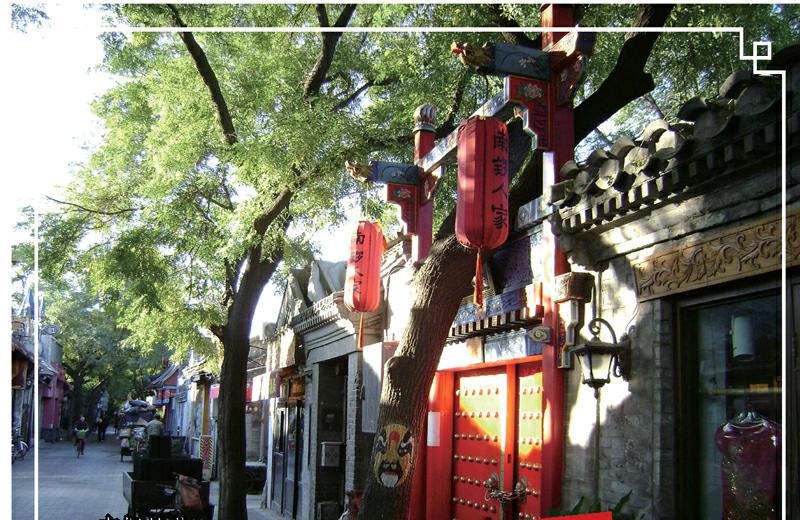中华文化英文讲系列
2016-06-08阿里尔鲁宾斯坦
阿里尔?鲁宾斯坦
有着800多年建都史的北京城具有丰富的市井文化,从老百姓居住的胡同、四合院,到民间杂耍、斗蛐蛐儿、养金鱼、遛鸟儿、鸽子哨,都同皇家文化一道,构成了北京悠久的历史文化传统。随着国际交往的不断加深,很多来北京的外国朋友已不再局限于游览恢弘的故宫、天坛、长城等经典景区,他们还愿意去胡同走走,坐坐人力三轮车,徜徉于市井民风中,感受最接地气的老北京文化。还有一些常驻北京工作、学习的外国朋友,也喜欢在周末和节假日出来走走逛逛,体味北京的风土人情。那么,如何用英语跟老外聊聊北京的民风民韵,让他们乘兴而来、满意而归呢?今儿个我们就先来了解一下北京的胡同,学习介绍胡同的英语表达吧!
我们现在通常所说的社区(community)其实在老北京人那里早就有了,那就是“胡同”。关于“胡同”的英文表达,有两种处理方法:一种是直接音译为hutong (英文中一般将hutong视为单复数同形,因此下面英文部分中复数形式的hutong也没有加s),了解中国文化的老外也都可以理解;还有一种方法就是采用英文中的对应词alley,alley在《柯林斯高阶英汉双解学习词典》中的英文释义如下:“An alley is a narrow passage or street with buildings or walls on both sides.”虽然alley不足以表达“胡同”的意思,但是对于初来中国、对中国文化不甚了解的外国人来说,alley这个词可能更容易理解。北京的胡同起源于元朝。通常认为,“胡同”一词最早来源于蒙古语,意思是“水井”,因为那时候人们的水源多是水井,生活的区域就是以水井为中心的。
在向外国朋友介绍胡同的概况时,可以参考下面这段英文表达。
Beijing has a community of alleys, or “hutong” in Chinese. These are the centuries-old, tree-lined alleyways that are the true heartbeat of this unique city and a real-life link to its fascinating past. The alleys go back almost 800 years to the Yuan Dynasty and are in fact a Mongol invention. After Genghis Khans (成吉思汗) unruly hordes reduced Beijing to rubble, the capital was redesigned with these narrow alleyways crisscrossing the city. In fact, the word “hutong” comes from the Mongolian word for “well,” as people living in that period inhabited areas around wells which were their source of water. By the Qing Dynasty there were 2,000 hutong, and by the 1950s that figure had almost trebled. (Based on BBC: Old Beijing at Its Timeless Best)
胡同的生活相比于现代化的城市生活有很多独特之处。闹中取静是胡同的一个显著特点——胡同地处城市中心,却没有集市和街道的喧哗。这是因为胡同一般比较狭窄,没有现代化交通工具带来的噪音,多是黄包车走街串巷。但是,这并不是说胡同里是死一般的沉寂,来来往往的小贩叫卖声仍然让胡同散发出生活的气息和生机。当然,城市现代化逐渐侵蚀了古老的胡同。现在,即使是在留存下来的胡同中,也免不了听到私家汽车的鸣笛声和马达声。
需要说明的是,在旧时,胡同里的主要交通工具并不是我们现在常看到的三轮脚踏车,而是黄包车。在英文里,“黄包车”一词是rickshaw,源于日语,在《柯林斯高阶英汉双解学习词典》的英文释义如下:“A rickshaw is a simple vehicle that is used in Asia for carrying passengers. Some rickshaws are pulled by a man who walks or runs in front.”旧时胡同里的黄包车对应的就是该释义的后一句话。
上文所述的胡同的特点可以用英文表达如下。
In the old days, life in the hutong remained peaceful and provided an escape from the hustle and bustle of city life. Although located downtown, the hutong were free from the noise of traffic, as they were too narrow to bear much. Instead, rickshaws went up and down and hawkers shouts greeted the whole neighborhood.
The modern life style, however, has gradually broken the tranquility as private cars have rushed into the hutong and the shouts of hawkers have disappeared as modern grocers and shops, as well as restaurants, bars and even clubs, have moved in to replace them.
胡同的名称——市井气息与历史文化同在
北京胡同的名称都可以追根溯源。如果用文字将北京每一条胡同的历史做一番梳理,那很可能是一部鸿篇巨制。分类说来,北京胡同的命名也五花八门:有以生活必需品命名的,有以历史名人命名的,有以旧时政府机构名称命名的,还有浪漫的名称和寄托美好愿望的名称。
关于北京胡同名称的概况,可以用下面这段英文来表达。
Just as the history of the hutong can be traced back about 800 years to the Yuan Dynasty, the names of individual hutong have also passed down their own traditions and culture. They are named after daily necessities, famous people or government sectors. Whats more, there are also names of romance and good wishes.
生活必需品最贴近老百姓的生活,因而以此命名的胡同不胜枚举。中国有句古话:“开门七件事,柴米油盐酱醋茶。”北京就有七个胡同的名字,一样不落地把这七件生活必需品囊括了进去,分别是:柴棒胡同、米市胡同、油坊胡同、盐店胡同、酱坊胡同、醋章胡同和茶儿胡同。
关于胡同名称与生活必需品的关系,可以用英文表达如下。
Daily necessities are the closest to peoples lives, so the number of hutong named after them is countless. An old Chinese sayings goes, “Firewood, rice, cooking oil, salt, soy sauce, vinegar and tea are the seven necessities of daily life.” As a result, there are seven hutong which are each named after one of these items.
为了纪念一些名人,我们会用名人的名字来命名道路、街道(如张自忠路)。古时也有用名人命名的胡同,如现在的红星胡同在1965年以前就叫做“无量大人胡同”,再早以前的名称是“吴良大人胡同”,正是得名于明朝大将吴良。
关于胡同名称与名人的关系,可以用英文表达如下。
In modern times, some roads or streets have been named after famous people in commemoration of them, such as Zhang Zizhong Road to honor the hero General Zhang Zizhong who sacrificed his life in the Chinese peoples War of Resistance Against Japan. In ancient times, the names of hutong also followed the same convention. For example, todays Red Star Hutong was originally called Milord Wu Liang Hutong, named after the famous general Wu Liang in the Ming Dynasty.
还有一些胡同是以旧时政府机构名称命名的。比如禄米仓胡同,就是旧时存储京官俸粮的地方。再比如府学胡同,是旧时官办的最高学校所在地。
这部分内容可以参考如下一段英文表达。
Some of the hutong got their names from the government sectors which were located in those hutong. The famous ones include Lumicang Hutong in which the granary for feudal officials salary was located, and Fuxue Hutong where the highest educational administration in feudal China used to be located.
对于有着浪漫气息的胡同名儿,外国人理解起来恐怕就有些难了。比如陈升的流行歌曲《北京一夜》中出现的“百花深处”,就是护国寺和新街口附近的一条胡同。2002年,英国的一家公司邀请世界上15位大师级导演各自拍摄10分钟的短片,串成一部叫做《十分钟年华老去》(Ten Minutes Older)的电影,旨在展示当代世界电影的最高艺术水准。制作方邀请的中国导演是陈凯歌,他所拍摄的短片就叫《百花深处》,译名为“100 Flowers Hidden Deep”,颇有几分诗意。还有人将“百花深处”翻译成Blooming Flowers Place,也说得通。对于诗意的中文名称,如何在功能对等的基础上翻译成英文,这本身就是见仁见智、众说纷纭的。
上面这段内容可以用英文表达如下。
It must be a little difficult for foreigners to appreciate the romance of some of the hutongs names. For example, the hutong mentioned in pop star Chen Shengs song “One Night in Beijing” is called “100 Flowers Hidden Deep,” as it was translated by the famous Chinese film director Chen Kaige in one of his movies. The name of this hutong has been translated as “Blooming Flowers Place” by others, while in fact, at present, it is only a shabby neighborhood without any flowers.
中华民间文化特别重视良好祝愿和吉利话,特别是喜欢“福禄寿喜”“平安吉祥”这样的字眼。这一点也体现在胡同的名称上,因此有福顺胡同、寿比胡同、寿逾百胡同、平安胡同、安福胡同、吉市口胡同、永祥胡同等多个这类名称的胡同。
上面这段内容可以用英文表达如下。
Chinese folk culture highlights good wishes of happiness, fortune and longevity, and auspicious words of safety, wellness and auspice. The custom is also reflected in the names of hutong, so a lot of hutong include these words in their names.
北京的胡同深藏着历史故事和百姓生活,从这个意义上说,她就是一部大书,既带你领略多姿多彩的老北京文化,又帮助你了解千奇百怪的人文历史。天气好的日子,带着你的外国朋友在胡同中走起来,还能练练你的英语口语呢!
